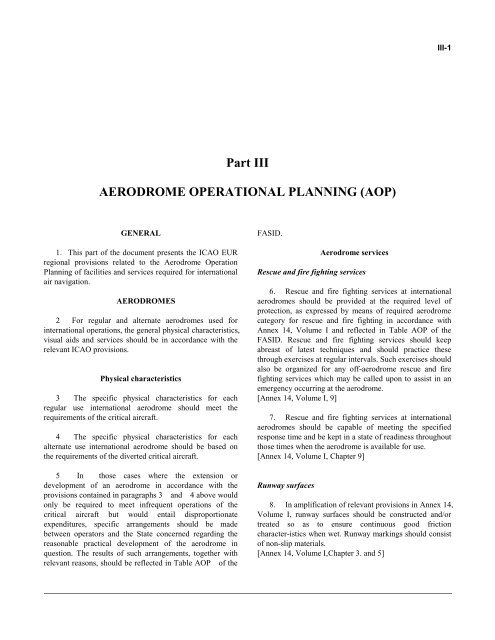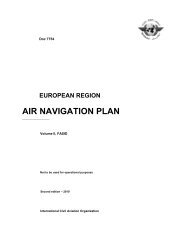7754 Vol 1 Flyleaf - ICAO Public Maps
7754 Vol 1 Flyleaf - ICAO Public Maps
7754 Vol 1 Flyleaf - ICAO Public Maps
You also want an ePaper? Increase the reach of your titles
YUMPU automatically turns print PDFs into web optimized ePapers that Google loves.
Part III<br />
AERODROME OPERATIONAL PLANNING (AOP)<br />
GENERAL<br />
1. This part of the document presents the <strong>ICAO</strong> EUR<br />
regional provisions related to the Aerodrome Operation<br />
Planning of facilities and services required for international<br />
air navigation.<br />
AERODROMES<br />
2 For regular and alternate aerodromes used for<br />
international operations, the general physical characteristics,<br />
visual aids and services should be in accordance with the<br />
relevant <strong>ICAO</strong> provisions.<br />
Physical characteristics<br />
3 The specific physical characteristics for each<br />
regular use international aerodrome should meet the<br />
requirements of the critical aircraft.<br />
4 The specific physical characteristics for each<br />
alternate use international aerodrome should be based on<br />
the requirements of the diverted critical aircraft.<br />
5 In those cases where the extension or<br />
development of an aerodrome in accordance with the<br />
provisions contained in paragraphs 3 and 4 above would<br />
only be required to meet infrequent operations of the<br />
critical aircraft but would entail disproportionate<br />
expenditures, specific arrangements should be made<br />
between operators and the State concerned regarding the<br />
reasonable practical development of the aerodrome in<br />
question. The results of such arrangements, together with<br />
relevant reasons, should be reflected in Table AOP of the<br />
FASID.<br />
Aerodrome services<br />
Rescue and fire fighting services<br />
III-1<br />
6. Rescue and fire fighting services at international<br />
aerodromes should be provided at the required level of<br />
protection, as expressed by means of required aerodrome<br />
category for rescue and fire fighting in accordance with<br />
Annex 14, <strong>Vol</strong>ume I and reflected in Table AOP of the<br />
FASID. Rescue and fire fighting services should keep<br />
abreast of latest techniques and should practice these<br />
through exercises at regular intervals. Such exercises should<br />
also be organized for any off-aerodrome rescue and fire<br />
fighting services which may be called upon to assist in an<br />
emergency occurring at the aerodrome.<br />
[Annex 14, <strong>Vol</strong>ume I, 9]<br />
7. Rescue and fire fighting services at international<br />
aerodromes should be capable of meeting the specified<br />
response time and be kept in a state of readiness throughout<br />
those times when the aerodrome is available for use.<br />
[Annex 14, <strong>Vol</strong>ume I, Chapter 9]<br />
Runway surfaces<br />
8. In amplification of relevant provisions in Annex 14,<br />
<strong>Vol</strong>ume I, runway surfaces should be constructed and/or<br />
treated so as to ensure continuous good friction<br />
character-istics when wet. Runway markings should consist<br />
of non-slip materials.<br />
[Annex 14, <strong>Vol</strong>ume I,Chapter 3. and 5]














